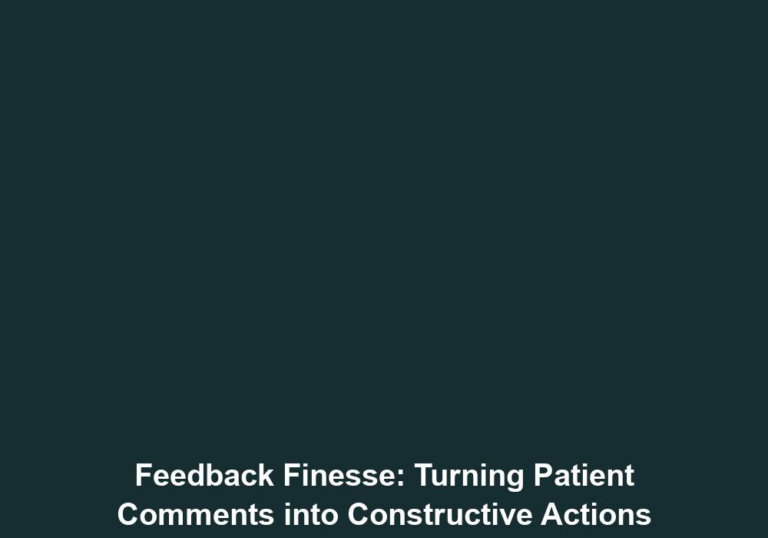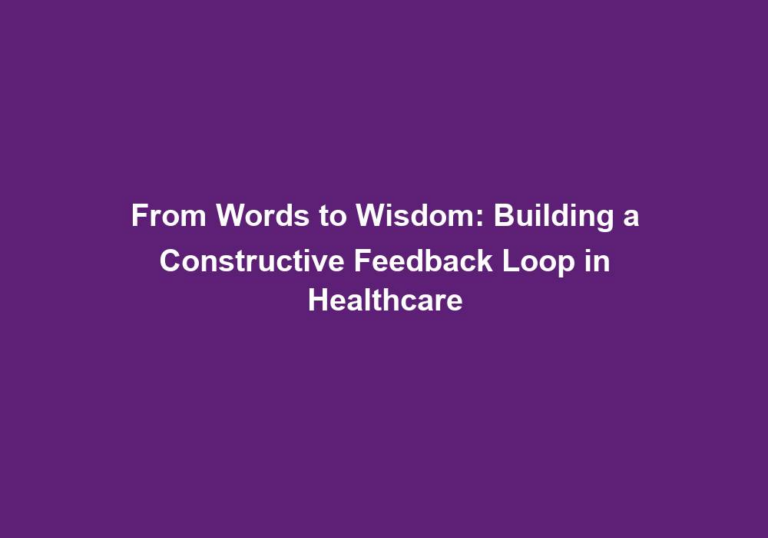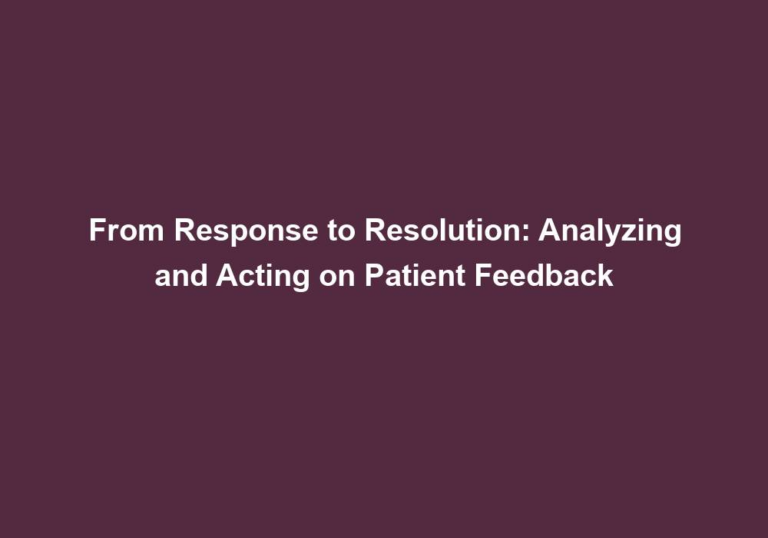Hearing in High Definition: Leveraging Real-time Patient Feedback Systems
In recent years, there has been a significant advancement in the field of audiology with the introduction of real-time patient feedback systems. These systems have revolutionized the way hearing professionals assess and fine-tune hearing aids to ensure optimal performance for individuals with hearing loss. This article explores the importance of leveraging real-time patient feedback systems and the benefits they bring to the audiology industry.
The Evolution of Hearing Aid Technology
Hearing aids have come a long way since their inception. From bulky, analog devices to sleek, digital and wireless devices, the technology has progressed by leaps and bounds. However, despite these advancements, hearing aids often require fine-tuning to meet the individual needs and preferences of each user. This is where real-time patient feedback systems come into play.
Real-time patient feedback systems are software programs integrated into modern hearing aids that allow users to provide immediate feedback on their listening experience. These systems utilize advanced algorithms to analyze the feedback and provide valuable insights to hearing professionals. By leveraging this technology, audiologists can make precise adjustments to the hearing aids, ensuring an optimal listening experience for their patients.
Benefits of Real-time Patient Feedback Systems
- Personalized Hearing Experience: Real-time patient feedback systems enable audiologists to tailor the settings of hearing aids to match the unique needs of each individual. By gathering feedback directly from the users, hearing professionals can make real-time adjustments to improve the clarity, volume, and overall satisfaction of the listening experience.
- With real-time patient feedback systems, audiologists can fine-tune the hearing aids based on the specific preferences and requirements of the individual. This customization leads to a more personalized hearing experience, enhancing the user’s overall satisfaction.
- By adjusting the settings in real-time, audiologists can address any issues or discomfort the user may be experiencing, ensuring that the hearing aids deliver the best possible sound quality for the individual.
- Efficient Problem Identification: Traditional methods of assessing hearing aid performance relied heavily on subjective feedback from patients during follow-up appointments. Real-time patient feedback systems eliminate the need for guesswork by providing objective data on the specific areas that require adjustment. This leads to more efficient problem identification and resolution.
- Real-time patient feedback systems provide audiologists with accurate data on the performance of hearing aids, allowing them to pinpoint any issues or areas that need improvement.
- By analyzing the objective data collected through these systems, audiologists can identify patterns and trends, which can help in diagnosing and resolving any problems more effectively.
- Faster Fine-tuning Process: With real-time patient feedback systems, the fine-tuning process becomes faster and more accurate. Audiologists can make adjustments based on the immediate feedback provided by the patients, reducing the number of follow-up appointments and minimizing the time it takes to achieve optimal hearing aid settings.
- Real-time patient feedback systems enable hearing professionals to make instant adjustments based on the feedback received, eliminating the need for multiple appointments and lengthy waiting times.
- By reducing the time required for fine-tuning, patients can experience improved hearing aid performance sooner, leading to greater overall satisfaction and better quality of life.
- Enhanced User Engagement: Real-time patient feedback systems empower individuals with hearing loss to actively participate in their hearing healthcare journey. By involving patients in the fine-tuning process, audiologists can improve patient satisfaction, compliance, and overall engagement with their hearing aids.
- By giving patients the ability to provide immediate feedback on their listening experience, they feel more involved and engaged in their own hearing healthcare.
- Actively involving patients in the fine-tuning process also increases their understanding of the technology and how it can be adjusted to meet their specific needs, leading to improved compliance and overall satisfaction.
- Data-driven Decision Making: Real-time patient feedback systems collect and analyze comprehensive data on the performance of hearing aids. This data can be used to identify trends, assess the effectiveness of different hearing aid models, and make data-driven decisions to improve overall patient outcomes.
- By analyzing the data collected through real-time patient feedback systems, audiologists can gain valuable insights into the performance of different hearing aid models and their impact on patient outcomes.
- The data-driven decision making facilitated by these systems allows hearing professionals to continuously improve their practice and provide the best possible hearing healthcare to their patients.
Implementing Real-time Patient Feedback Systems
To successfully leverage real-time patient feedback systems, hearing professionals need to adopt the following steps:
- Education and Training: Audiologists should familiarize themselves with the functionality and features of real-time patient feedback systems. Ongoing education and training are essential to ensure audiologists can effectively interpret and utilize the feedback provided by the system.
- Audiologists should stay updated with the latest advancements in real-time patient feedback systems and undergo training to fully understand how to integrate them into their practice.
- Continuous education and training help audiologists make the most of the feedback provided by these systems, allowing them to deliver the best possible hearing healthcare.
- Collaboration with Manufacturers: Hearing aid manufacturers play a crucial role in the successful implementation of real-time patient feedback systems. Audiologists should collaborate with manufacturers to integrate the technology seamlessly into their practice and stay updated with the latest advancements in the field.
- Building strong partnerships with hearing aid manufacturers ensures that audiologists have access to the most up-to-date technology and support.
- Collaborating with manufacturers also allows audiologists to provide valuable feedback and contribute to the improvement of real-time patient feedback systems.
- Patient Education: It is important to educate patients about the benefits of real-time patient feedback systems. Explaining the purpose and functionality of these systems will encourage patients to actively participate in the fine-tuning process and provide valuable feedback.
- Audiologists should take the time to explain to patients how real-time patient feedback systems work and how their involvement can lead to a better hearing experience.
- Educating patients about the benefits of providing feedback and the impact it can have on the fine-tuning process motivates them to actively participate, leading to improved outcomes.
- Regular Follow-up and Monitoring: Audiologists should establish a regular follow-up schedule to monitor the effectiveness of hearing aid adjustments made based on patient feedback. This allows for continuous improvement and ensures the best possible hearing experience for patients.
- Regular follow-up appointments help audiologists track the progress of patients and make any necessary adjustments to their hearing aids.
- By monitoring the effectiveness of the adjustments made based on patient feedback, audiologists can ensure that their patients continue to experience optimal hearing aid performance.
Conclusion
Real-time patient feedback systems have transformed the audiology industry by providing valuable insights into the listening experience of individuals with hearing loss. By leveraging this technology, audiologists can deliver a personalized and efficient hearing healthcare experience. The implementation of real-time patient feedback systems requires education, collaboration, and patient engagement to ensure optimal outcomes. Embracing these systems allows hearing professionals to enter a new era of hearing aid fine-tuning, where the needs and preferences of each individual are met with precision and accuracy.







